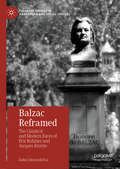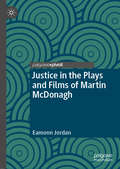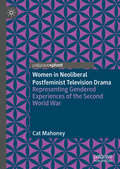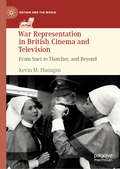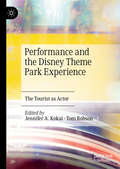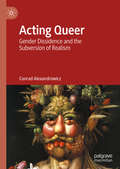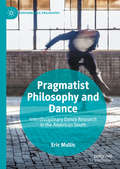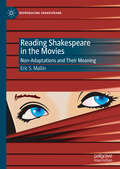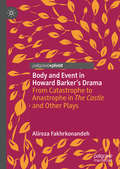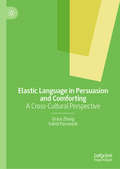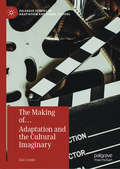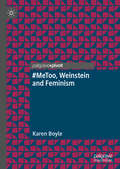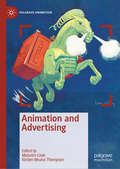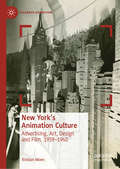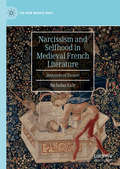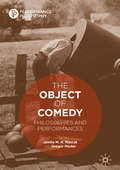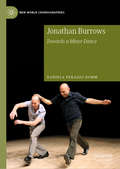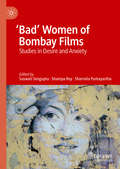- Table View
- List View
Balzac Reframed: The Classical and Modern Faces of Éric Rohmer and Jacques Rivette (Palgrave Studies in Adaptation and Visual Culture)
by Zahra Tavassoli ZeaThis book examines the theoretical affiliations between the most notable proponent of literary realism, Honoré de Balzac, and two understated but key representatives of the French New Wave, Éric Rohmer and Jacques Rivette. It argues that their film criticism, which gradually led to the establishment of a common aesthetic vision of cinema (the “politique des auteurs”), owes more to Balzac and the nineteenth-century novel than to any intellectual trend of the immediate post-war period. By considering the films of Rohmer and Rivette as an extension of their writings (essays, film reviews, scriptwriting, novels and interviews), this volume analyses the changing and sometimes opposed ways in which they applied Balzacian principles and themes to their cinematic practice. Essentially, it understands the exchange between art forms, past traditions and contemporaneous currents as the overlooked yet common thread that links these three authors, through their own re-appropriations of classical and romantic aesthetics in their explorations of modern French society. In doing so, this study provides further nuance to the “conservative” versus “progressist” rupture that is generally assumed between the two directors, and offers an innovative reading of The Human Comedy in the light of post-war ideas on authorship, film adaptation, classicism and modernism.
Displacements: Reading Space and Time in Moving Image Installations (Palgrave Close Readings in Film and Television)
by Alison ButlerThis book is about the aesthetics and politics of contemporary artists’ moving image installations, and the ways that they use temporal and spatial relationships in the gallery to connect with geopolitical issues. Displaced from the cinema, moving images increasingly address themes of movement and change in the world today. Digital technology has facilitated an explosion of work of this kind, and the expansion of contemporary art museums, biennales and large-scale exhibitions all over the world has created venues and audiences for it. Despite its 20th century precursors, this is a new and distinct artistic form, with an emerging body of thematic concerns and aesthetics strategies. Through detailed analysis of a range of important 21st century works, the book explores how this spatio-temporal form has been used to address major issues of our time, including post-colonialism, migration and conflict. Paying close attention to the ways in which moving images interact with the specific spaces and sites of exhibition, the book explores the mobile viewer’s experiences in these immersive and transitory works.
Justice in the Plays and Films of Martin McDonagh
by Eamonn JordanThis book interrogates the various manifestations of rival systems of justice in the plays and films of Martin McDonagh, in analysis informed by the critical writings of Michael J. Sandel, Steven Pinker, Julia Kristeva, and in particular Amartya Sen on violence, justice, equality and the law. In McDonagh’s works, failures to investigate adequately criminal actions are matched by multiple forced confessions and umpteen miscarriages of justice. The author explores McDonagh’s creative worlds as ones where distinctions between victim and perpetrator and guilt and innocence are precarious, where the burden of truth seldom reaches the threshold of beyond reasonable doubt and where the punishments and rewards of justice are applied randomly. This project considers the abject nature of justice in McDonagh’s writing, with the vast implications of justice being fragile, suspect, piecemeal, deviant, haphazard and random. Tentative forms of justice are tempered and then threatened by provocative, anarchic and abject humour. As the author argues, McDonagh’s writing cleverly circulates rival, incompatible and comparative systems of justice in order to substantiate the necessities and virtues of justice.
Women in Neoliberal Postfeminist Television Drama: Representing Gendered Experiences of the Second World War
by Cat Mahoney“In this insightful book, Cat Mahoney offers a fascinating analysis of contemporary TV dramas such as Home Fires, Land Girls and The Bletchley Circle. Developing the idea that history is told through the preoccupations of the present, she argues compellingly that these are postfeminist dramas which work through troubling ideas about heteronormative romance, domesticity, beauty and whiteness, while reinforcing the idea that feminism as a political movement is not necessary. A bold and original contribution to television studies, gender studies and popular history.” ̶ Rosalind Gill, City, University of London, UK By examining contemporary television drama set during and immediately after the Second World War, this book illustrates the ways in which postfeminism has shaped representations of women in contemporary culture. Mahoney offers a new perspective to debates that have previously been concerned with questions of historical accuracy. She argues that depictions of women from the past in modern television drama spawn from the neoliberal postfeminist media climate which originated in the 1990s. These depictions respond to a cultural need to naturalise and de-historicise a version of neoliberal postfeminist femininity that is compatible with the current media climate and far more reflective of the concerns of the present than any “real” or lived experience of women in the past. The result of this process of naturalisation is the assertion that postfeminist values are natural and eternal, rather than a product of the 1980s economic turn and the present political moment. By identifying and interrogating postfeminist norms within four television drama series produced since the 2008 financial crash, this book argues that postfeminism is a dominant structuring force in their depiction of female characters and of the past.
Immigrants on Grindr: Race, Sexuality and Belonging Online
by Andrew DJ ShieldThis book examines the role of hook-up apps in the lives of gay, bi, trans, and queer immigrants and refugees, and how the online culture of these platforms promotes belonging or exclusion. Within the context of the so-called European refugee crisis, this research focuses on the experiences of immigrants from especially Muslim-majority countries to the greater Copenhagen area, a region known for both its progressive ideologies and its anti-immigrant practices. Grindr and similar platforms connect newcomers with not only dates and sex, but also friends, roommates and other logistical contacts. But these socio-sexual platforms also become spaces of racialization and othering. Weaving together analyses of real Grindr profile texts, immigrant narratives, political rhetoric, and popular media, Immigrants on Grindr provides an in-depth look at the complex interplay between online and offline cultures, and between technology and society.
War Representation in British Cinema and Television: From Suez to Thatcher, and Beyond (Britain and the World)
by Kevin M. FlanaganThis book explores alternatives to realist, triumphalist, and heroic representations of war in British film and television. Focusing on the period between the Suez Crisis of 1956 and the Falkland War but offering connections to the moment of Brexit, it argues that the “lost continent” of existential, satirical, simulated, and abstractly traumatic war stories is as central to understanding Britain’s martial history as the mainstream inheritance. The book features case studies that stress the contribution of exiled or expatriate directors and outsider sensibilities, with particular emphasis on Peter Watkins, Joseph Losey, and Richard Lester. At the same time, it demonstrates concerns and stylistic emphases that continue to the present in television series and films by directors such as Lone Scherfig and Christopher Nolan. Encompassing everything from features to government information films, the book explores related trends in the British film industry, popular culture, and film criticism, while offering a sense of how these contexts contribute to historical memory.
Cinema of the Arab World: Contemporary Directions in Theory and Practice (Global Cinema)
by Terri Ginsberg Chris LippardThis volume engages new films and modes of scholarly research in Arab cinema, and older, often neglected films and critical topics, while theorizing their structural relationship to contemporary developments in the Arab world. The volume considers the relationship of Arab cinema to transnational film production, distribution, and exhibition, in turn recontextualizing the works of acknowledged as well as new directorial figures, and country-specific phenomena. New documentary and experimental practices are referenced and critiqued, while commercial cinema is covered both as an industrial product and as one of several instances of contestation. The volume thus showcases the breadth and depth of Arab film culture and its multilayered connections to local conditions, regional affiliations, and the tendencies and aesthetics of global cinema.
Performance and the Disney Theme Park Experience: The Tourist as Actor
by Jennifer A. Kokai Tom RobsonThis book addresses Disney parks using performance theory. Few to no scholars have done this to date—an enormous oversight given the Disney parks’ similarities to immersive theatre, interpolation of guests, and dramaturgical construction of attractions. Most scholars and critics deny agency to the tourist in their engagement with the Disney theme park experience. The vast body of research and journalism on the Disney “Imagineers”—the designers and storytellers who construct the park experience—leads to the misconception that these exceptional artists puppeteer every aspect of the guest’s experience. Contrary to this assumption, Disney park guests find a range of possible reading strategies when they enter the space. Certainly Disney presents a primary reading, but generations of critical theory have established the variety of reading strategies that interpreters can employ to read against the text. This volume of twelve essays re-centers the park experience around its protagonist: the tourist.
Acting Queer: Gender Dissidence and the Subversion of Realism
by Conrad AlexandrowiczThis book is situated at the intersection of queer/gender studies and theories of acting pedagogy and performance. It explores the social and cultural matrix in which matters of gender are negotiated, including that of post-secondary theatre and drama education. It identifies the predicament of gender dissident actors who must contend with the widespread enforcement of realist paradigms within the academy, and proposes a re-imagining of the way drama/theatre/performance are practised in order to serve more fairly and effectively the needs of queer actors in training. This is located within a larger project of critique in reference to the art form as a whole. The book stimulates discussion among practitioners and scholars on matters concerning various kinds of diversity: of gender expression, of approaches to the teaching of acting, and to the way the art form may be imagined and executed in the early years of the 21st Century, in particular in the face of the climate crisis. But it is also an aid to practitioners who are seeking new theoretical and practical approaches to dealing with gender diversity in acting pedagogy.
Pragmatist Philosophy and Dance: Interdisciplinary Dance Research in the American South (Performance Philosophy)
by Eric MullisThis book investigates how Pragmatist philosophy as a philosophical method contributes to the understanding and practice of interdisciplinary dance research. It uses the author's own practice-based research project, Later Rain, to illustrate this. Later Rain is a post-dramatic dance theater work that engages primarily with issues in the philosophy of religion and socio-political philosophy. It focuses on ecstatic states that arise in Appalachian charismatic Pentecostal church services, states characterized by dancing, paroxysms, shouting, and speaking in tongues (glossolalia). Research for this work is interdisciplinary as it draws on studio practice, ethnographic field work, cultural history, Pentecostal history and theology, folk aesthetics, anthropological understandings of ecstatic religious rituals, and dance history regarding acclaimed works that have sought to present aspects of religious ecstasy on stage; Doris Humphrey's The Shakers (1931), Mark Godden’s Angels in the Architecture (2012), Martha Clarke’s Angel Reapers (2015) and Ralph Lemon’s Geography trilogy (2005). The project thereby demonstrates a process model of dance philosophy, showing how philosophy and dance artistry intertwine in a specific creative process.
Reading Shakespeare in the Movies: Non-Adaptations and Their Meaning (Reproducing Shakespeare)
by Eric S. MallinReading Shakespeare in the Movies: Non-Adaptations and Their Meaning analyzes the unacknowledged, covert presence of Shakespearean themes, structures, characters, and symbolism in selected films. Writers and directors who forge an unconscious, unintentional connection to Shakespeare’s work create non-adaptations, cinema that is unexpectedly similar to certain Shakespeare plays while remaining independent as art. These films can illuminate core semantic issues in those plays in ways that direct adaptations cannot. Eric S. Mallin explores how Shakespeare illuminates these movies, analyzing the ways that The Godfather, Memento, Titanic, Birdman, and The Texas Chainsaw Massacre take on new life in dialogue with the famous playwright. In addition to challenging our ideas about adaptation, Mallin works to inspire new awareness of the meanings of Shakespearean stories in the contemporary world.
Body and Event in Howard Barker's Drama: From Catastrophe to Anastrophe in The Castle and Other Plays
by Alireza FakhrkonandehThis book explores questions of gender, desire, embodiment, and language in Barker’s oeuvre. With The Castle as a focal point, the scope extends considerably beyond this play to incorporate analysis and exploration of the Theatre of Catastrophe; questions of gender, subjectivity and desire; God/religion; aesthetics of the self; autonomy-heteronomy; ethics; and the relation between political and libidinal economy, at stake in 20 other plays by Barker (including Rome, The Power of the Dog, The Bite of the Night, Judith, Possibilities, I Saw Myself, Fence in Its Thousandth Year, The Gaoler’s Ache for the Nearly Dead, The Brilliance of the Servant, Golgo, among others).
Elastic Language in Persuasion and Comforting: A Cross-Cultural Perspective
by Grace Zhang Vahid ParvareshThis innovative book examines the discourse of reality television, and the elasticity of language in the popular talent show The Voice from a cross-cultural perspective. Analysing how and why elastic language is used in persuasion and comforting, a comparison between Chinese and English is made, and the authors highlight the special role that elastic language plays in effective interactions and strategic communication. Through the lens of the language variance of two of the world’s most commonly spoken languages, the insights and resources provided by this book are expected to advance knowledge in the fields of contrastive pragmatics and cross-cultural communication, and inform strategies in bridging different cultures. This study highlights the need to give the elastic use of language the attention it deserves, and reveals how language is non-discrete and strategically stretchable. This book will be of interest to academics and postgraduate students engaged in elastic/vague language studies, cross-cultural pragmatics, media linguistics, discourse analysis, sociolinguistics and communication studies.
The Making of… Adaptation and the Cultural Imaginary (Palgrave Studies in Adaptation and Visual Culture)
by Jan CroninThis book explores “Making of” sites as a genre of cultural artefact. Moving beyond “making-of” documentaries, the book analyses novels, drama, film, museum exhibitions and popular studies that re-present the making of culturally loaded film adaptations. It argues that the “Making of” genre operates on an adaptive spectrum, orienting towards and enacting the adaptation of films and their making. The book examines the behaviours that characterise “Making of” sites across visual media; it explores the cultural work done by these sites, why recognition of “Making of” sites as adaptations matters, and why our conception of adaptation matters. Part one focuses on the adaptive domain presented by the “Making of” John Ford’s The Quiet Man. Part two attends to “Making of” Gone with the Wind sites, and concludes with “Making of” The Lord of the Rings texts as the acme of the cultural risks and investments charted in earlier chapters.
Hong Kong Dark Cinema: Film Noir, Re-conceptions, and Reflexivity (East Asian Popular Culture)
by Kim-Mui E. ChanThis book is a scholarly investigation of the historical development and contemporary transformation of film noir in today’s Hong Kong. Focusing on the evolvement of cinematic narratives, aesthetics, and techniques, the author balances a deep reading of the multiple filmic plots with a discussion of the cinematic portrayals of gender, romance, identities and power relations. Nuancing the prototypical cinematic form and tragic sense of classical film noir, the recent Hong Kong cinema turns around the classical generic role of film noir at the turn of the century to convey very different messages—joy, hope or love. This book examines how the mainstream cinema, or pre-and-post-Hong Kong cinema in particular, applies a peculiar strategy that makes rooms for the audience to enjoy a pleasure-giving process of reflexivity and also critique the mainstream ideology. With new analytical approaches and angles, this book breaks new ground in offering transcultural and cross-genre analyses on the cinema and its impact in local and international markets. This book is the first major scholarly investigation of the historical development and contemporary transformation of film noir in today’s Hong Kong. Focusing on the evolvement of cinematic narratives, aesthetics, and techniques, the author balances a deep reading of the multiple filmic plots with a refreshing discussion of the cinematic portrayals of gender, romance, identities and power relations. This book also revisits conceptual categories developed by Foucault, Lacan, Derrida and Butler.
#MeToo, Weinstein and Feminism
by Karen BoyleThis book provides a feminist analysis of #MeToo and the sexual assault allegations against celebrity perpetrators which have emerged since the Weinstein story of October 2017. It argues for the importance of understanding #MeToo in relation to an on-going history of Anglo-American feminist activism, theory and interdisciplinary research. Boyle investigates how speaking out about rape, sexual assault and harassment on social media can be understood in relation to second-wave feminist traditions of consciousness-raising. Her argument explores the media depiction of feminism – and feminists - in the wake of Weinstein and the cultural values associated with men’s abuse, particularly within the film and television industries. The book concludes with an exploration of what the #MeToo era has meant for men as victims/survivors and as alleged perpetrators, in relation to narratives of victimisation and of monstrosity.
Theorizing Stupid Media: De-Naturalizing Story Structures in the Cinematic, Televisual, and Videogames
by Aaron Kerner Julian HoxterThis book explores the stupid as it manifests in media—the cinema, television and streamed content, and videogames. The stupid is theorized not as a pejorative term but to address media that “fails” to conform to established narrative conventions, often surfacing at evolutionary moments. The Transformers franchise is often dismissed as being stupid because its stylistic vernacular privileges kinetic qualities over conventional narration. Similarly, the stupid is often present in genre fails like mother!, or in instances of narrative dissonance—joyously in Adventure Time; more controversially in Gone Home— where a story “feels off” It also manifests in “ludonarrative dissonance” when gameplay and narrative seemingly run counter to one another in videogames like Undertale and Bioshock. This book is addressed to those interested in media that is quirky, spectacle-driven, or generally hard to place—stupid!
Immersive Embodiment: Theatres of Mislocalized Sensation (Palgrave Studies in Performance and Technology)
by Liam JarvisThis book offers a wide-ranging examination of acts of ‘virtual embodiment’ in performance/gaming/applied contexts that abstract an immersant’s sense of physical selfhood by instating a virtual body, body-part or computer-generated avatar. Emergent ‘immersive’ practices in an increasingly expanding and cross-disciplinary field are coinciding with a wealth of new scientific knowledge in body-ownership and self-attribution. A growing understanding of the way a body constructs its sense of selfhood is intersecting with the historically persistent desire to make an onto-relational link between the body that ‘knows’ an experience and bodies that cannot know without occupying their unique point of view. The author argues that the desire to empathize with another’s ineffable bodily experiences is finding new expression in contexts of particular urgency. For example, patients wishing to communicate their complex physical experiences to their extended networks of support in healthcare, or communities placing policymakers ‘inside’ vulnerable, marginalized or disenfranchised virtual bodies in an attempt to prompt personal change. This book is intended for students, academics and practitioner-researchers studying or working in the related fields of immersive theatre/art-making, arts-science and VR in applied performance practices.
Animation and Advertising (Palgrave Animation)
by Malcolm Cook Kirsten Moana ThompsonThroughout its history, animation has been fundamentally shaped by its application to promotion and marketing, with animation playing a vital role in advertising history. In individual case study chapters this book addresses, among others, the role of promotion and advertising for anime, Disney, MTV, Lotte Reiniger, Pixar and George Pal, and highlights American, Indian, Japanese, and European examples. This collection reviews the history of famous animation studios and artists, and rediscovers overlooked ones. It situates animated advertising within the context of a diverse intermedial and multi-platform media environment, influenced by print, radio and digital practices, and expanding beyond cinema and television screens into the workplace, theme park, trade expo and urban environment. It reveals the part that animation has played in shaping our consumption of particular brands and commodities, and assesses the ways in which animated advertising has both changed and been changed by the technologies and media that supported it, including digital production and distribution in the present day. Challenging the traditional privileging of art or entertainment over commercial animation, Animation and Advertising establishes a new and rich field of research, and raises many new questions concerning particular animation and media histories, and our methods for researching them.
New York's Animation Culture: Advertising, Art, Design and Film, 1939–1940 (Palgrave Animation)
by Kristian MoenThis book reveals and explores the thriving animation culture in midtown Manhattan, the World’s Fair, art galleries and cinemas during a vibrant period of artistic, commercial and industrial activity in New York City. Alongside a detailed investigation of animated film at the time – ranging from the abstract works of Mary Ellen Bute and Norman McLaren to the exhibition practices of the Disney Studios and the New York World’s Fair – New York’s Animation Culture examines a host of other animated forms, including moving dioramas, illuminated billboards, industrial displays, gallery exhibitions, mobile murals, and shop windows. In this innovative microhistory of animation, Moen combines the study of art, culture, design and film to offer a fine-grained account of an especially lively animation culture that was seen as creating new media, expanding the cinema experience, giving expression to utopian dreams of modernity, and presenting dynamic visions of a kinetic future.
Narcissism and Selfhood in Medieval French Literature: Wounds of Desire (The New Middle Ages)
by Nicholas EalyThis book offers analyses of texts from medieval France influenced by Ovid’s myth of Narcissus including the Lay of Narcissus, Alain de Lille’s Plaint of Nature, René d’Anjou’s Love-Smitten Heart, Chrétien de Troyes’s Story of the Grail and Guillaume de Machaut’s Fountain of Love. Together, these texts form a corpus exploring human selfhood as wounded and undone by desire. Emerging in the twelfth century in Western Europe, this discourse of the wounded self has survived with ever-increasing importance, informing contemporary methods of theoretical inquiry into mourning, melancholy, trauma and testimony. Taking its cue from the moment Narcissus bruises himself upon learning he cannot receive the love he wants from his reflection, this book argues that the construct of the wounded self emphasizes fantasy over reality, and that only through the world of the imagination—of literature itself—can our narcissistic injuries seemingly be healed and desire fulfilled.
Sidi Larbi Cherkaoui: Dramaturgy and Engaged Spectatorship (New World Choreographies)
by Lise UytterhoevenThis book analyses the world-renowned Belgian choreographer’s key approaches and dramaturgical strategies through selected case studies from his oeuvre between 2000 and 2010, from Rien de Rien to Babel(words). It investigates Cherkaoui’s choreographic and dramaturgic interventions in debates on the nation, culture, religion and language, by emphasising the transcultural, transreligious and geopolitical dimensions of the dialogues and exchanges he explored during this initial decade. Engaged spectatorship refers to the ongoing thinking, talking, research and writing that the spectator is invited to do in order to fulfil the work’s macro-dramaturgical potential to resist nationalism, populism and religious fundamentalism. The book meticulously explores Cherkaoui’s rich, multi-layered theatrical imagery and aural landscapes to demonstrate the agile and ever-shifting interpretive acts the works elicit from their audiences. Offering a full-length analysis of Cherkaoui’s work, the book is essential reading for students, researchers, practitioners and Cherkaoui fans.
The Object of Comedy: Philosophies and Performances (Performance Philosophy)
by Jamila M. H. Mascat Gregor ModerWhat is the object of comedy? What makes us laugh and why? Is comedy subversive, restorative or reparative? What is at stake politically, socially and metaphysically when it comes to comedic performances? This book investigates not only the object of comedy but also its objectives – both its deliberate goals and its unintended side effects.In researching the object of comedy, the contributions gathered here encounter comedy as a philosophical object: instead of approaching comedy as a genre, the book engages with it as a language, a medium, an artifice, a weapon, a puzzle or a trouble, a vocation and a repetition. Thus philosophy meets comedy at the intersection of various fields (e.g. psychoanalysis, film studies, cultural studies, and performance studies) –regions that comical practices and theories in fact already traverse.
Jonathan Burrows: Towards a Minor Dance (New World Choreographies)
by Daniela Perazzo DommThe first monograph on the work of British choreographer Jonathan Burrows, this book examines his artistic practice and poetics as articulated through his choreographic works, his writings and his contributions to current performance debates. It considers the contexts, principles and modalities of his choreography, from his early pieces in the 1980s to his latest collaborative projects, providing detailed analyses of his dances and reflecting on his unique choreomusical partnership with composer Matteo Fargion.Known for its emphasis on gesture and humour, and characterised by compositional clarity and rhythmical patterns, Burrows’ artistic work takes the language of choreography to its limits and engages in a paradoxical, and hence transformative, relationship with dance’s historical and normative structures. Exploring the ways in which Burrows and Fargion’s poetics articulates movement, performative presence and the collaborative process in a ‘minor’ register, this study conceptualises the work as a politically compelling practice that destabilises major traditions from a minoritarian position.
'Bad' Women of Bombay Films: Studies in Desire and Anxiety
by Saswati Sengupta Shampa Roy Sharmila PurkayasthaThis book presents a feminist mapping of the articulation and suppression of female desire in Hindi films, which comprise one of modern India’s most popular cultural narratives. It explores the lineament of evil and the corresponding closure of chastisement or domesticity that appear as necessary conditions for the representation of subversive female desire. The term ‘bad’ is used heuristically, and not as a moral or essential category, to examine some of the iconic disruptive women of Hindi cinema and to uncover the nexus between patriarchy and other hierarchies, such as class, caste and religion in these representations. The twenty-one essays examine the politics of female desire/s from the 1930s to the present day - both through in-depth analyses of single films and by tracing the typologies in multiple films. The essays are divided into five sections indicating the various gendered desires and rebellions that patriarchal society seeks to police, silence and domesticate.
